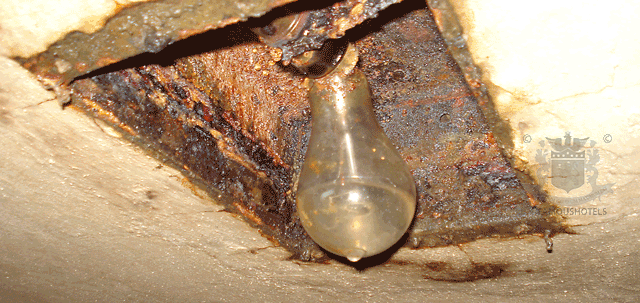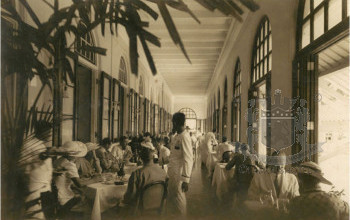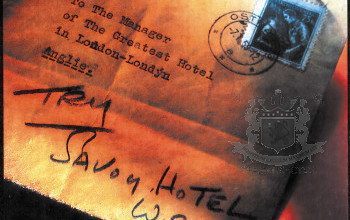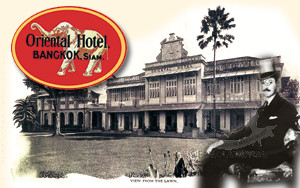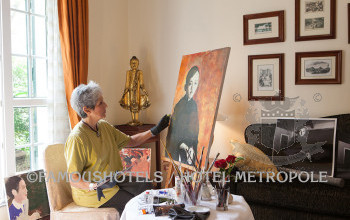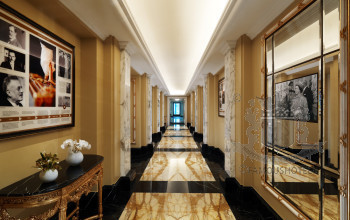Metropole Hanoi: bunker discovered
( words)
Unearthing History
by Andreas Augustin
what a gift you've given me,
To smile at me and quietly
let me share your agony,
And I can only bow in utter humbleness and ask,
Forgiveness and forgiveness for the things
we've brought to pass.
Joan Baez, Where are you now my son?

Kai Speth, the general manager of the Hotel Metropole in Hanoi was all excited. Many years ago I had written a book about the history of the Hotel Metropole in Hanoi. There were rumours about a bunker in the courtyard, a relic from the American War. It had to be buried under two meters of soil, reinforced concrete and heaven knows what. The pool was noticeably shallower at one end. 'It’s the bunker, you know,' everybody used to say. But, nobody had ever considered to search for it, much less to reopen it.
The bunker was built during the American War. As the US Air Force closed in, it was impossible to guarantee the safety of the hotel's guests, among them travellers from all over the world and, ironically, various Americans like Jane Fonda and Joan Baez. The Vietminh army moved in heavy machinery to create a hole ten by ten metres in area, around five metres deep. A solid concrete construction was built within this crater. The walls were made of reinforced concrete about 30 centimetres thick, the ceiling allows a person of 185cm of height to stand upright.
One of our first records of the bunker comes from Gemma Cruz Araneta, the famous Filipino journalist, who visited Hanoi in May 1968: '... at 2:30, a siren bellowed – the air raid alarm! Electricity was suddenly shut off in the hotel and someone banged on our door... Most of the hotel guests were assembled at the lobby except for the American students, three draft dodgers and one lady New Yorker, who are the first ones to go to the shelter. The hotel shelter is a long, narrow, semi-subterranean room of concrete, which I thought would have made a groovy discotheque. It is lined with green wooden chairs and though there was no electricity, I noticed an electric fan. Really, the Vietnamese are such thoughtful hosts…'
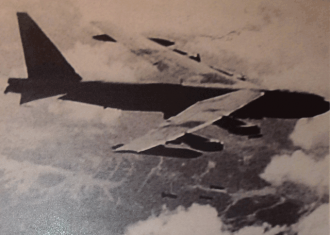
B52 over North Vietnam, 1972
The bunker was used throughout the war, but raised to life-saving importance during Operation Linebacker, which was conducted from May to October 1972. At that time hotel guest Jane Fonda made her brave radio speech. On 22 August 1972 she was heard: ‘This is Jane Fonda. During my two week visit in the Democratic Republic of Vietnam, ... In the shadow of the Temple of Literature I saw Vietnamese actors and actresses perform the second act of Arthur Miller’s play All My Sons. I don’t think that the people of Vietnam are about to compromise in any way, ... and I think Richard Nixon would do well to read Vietnamese history, particularly their poetry, …'
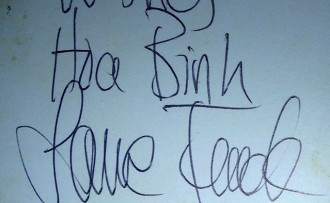
Jane Fonda in the Metropole's air raid shelter, a photograph she personally autographed with the Vietnamese words of 'Peace'
© Reproduced by Andreas Augustin
During Christmas 1972, Operation Linebacker II commenced, an aerial bombing campaign, which lasted from 18–29 December 1972, leading to several nicknames such as ‘The December Raids’ and ‘The Christmas Bombings’. It saw the largest heavy bomber strikes launched by the US Air Force since the end of World War II. Its targets were, among others, the city of Hanoi and its civil population. 1,600 people died in Hanoi and Haiphong in the raids.
During that period the air raid shelter at the hotel was used constantly.
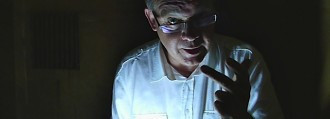
Andreas Augustin down there: Up to three times a night you had to flee into the bunker.
Sometimes guests had to rise three times in a night to run down to the bunker. The bombers were spotted about 40 kilometres south of Hanoi, and it took 10 minutes for them to reach Hanoi airspace. Some guests simply stayed in the shelter for the entire night.
Singer, songwriter and activist Joan Baez spent thirteen days in Vietnam and returned home with fifteen hours of tapes. ‘Where Are You Now, My Son?’, the title track of the resulting album, runs to twenty-two minutes. It is spoken as well as sung, and includes actual recordings from the hotel, from the massive Christmas bombing raids on Hanoi, from hours spent in the bunker of the hotel, from Christmas songs sung in the lobby of the hotel.
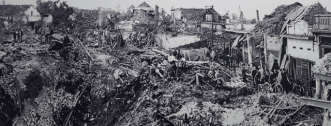
Joan Baez and Norbert Putnam visited Kham Thien street, which was levelled at 10:45 pm on December 26 1972. You can hear the explosion of the bombs in the distance. Sometimes the hits were very close. Anti-aircraft fire sounds from nearby.

Bamboo Bar and pool
With the reopening of the hotel in the 1990s, a ‘Bamboo Bar’ at the shallow end of the pool was built on top of the bunker. In 2011, construction workers laying the foundation of a new Bamboo Bar stumbled upon a solid layer of concrete, which they found impossible to penetrate. Now general manager Kai Speth and chief engineer Vincent Gil M Altamirano tried to find a way into what they assumed must be the bunker of the hotel, the existence of which they had learned from my book Hotel Metropole Hanoi.
After excavating more than two meters of earth and reinforced concrete and then jack-hammering through the 278 -millimetre ceiling, the hotel opened the hatch on a warren of flooded corridors, chambers and stairways.
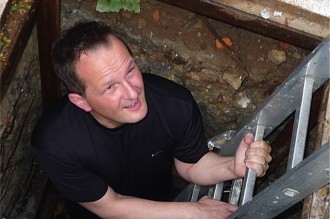
Kai Speth was down first, confessing that he had goose-pimples.
Later, when I lowered myself down the five meter ladder, I first had to climb through the outer shell of the construction. It was a mishmash of stones, concrete and reinforced iron rods. Outside the air had been a pleasant 25°C. Down in the bunker it was much hotter. The dampness from four decades of water-filled concrete rooms was immediately apparent.
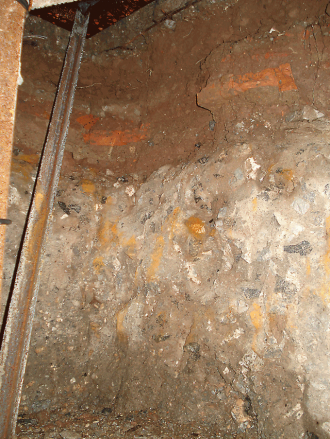
The outer shell of the bunker
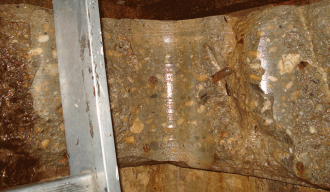
The ceiling itself - 27 cm concret, reinforced
I crawled deeper. My back scraped against a piercing rod of iron. I had reached the ceiling of the bunker. Now I could see it perfectly. The engineers had cut a small rectangular opening just big enough for a man to pass through. When I was at eye-level with the ceiling, I saw its construction: solid concrete, masses of iron reinforcement, 27 centimetres thick.
As my feet reached into bunker, I took one more look upwards. The blue sky was visible through the tiny hole. Suddenly I touched the ground. My rubber boots stood in water. Ankle deep. I waded forward very slowly. A bright torchlight, held by one of the hotel's engineers, lit up a long, narrow room.
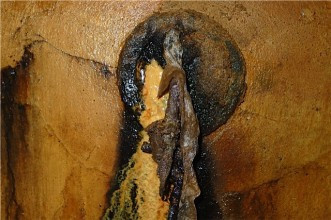 I had made myself familiar with shelters in the past. Typical shelters were constructed with several small rooms rather than one big hall. There were two reasons for this: first of all if you received a direct hit you had more supporting walls, and only one part of the shelter might be damaged, secondly panic doesn't spread so easily.
I had made myself familiar with shelters in the past. Typical shelters were constructed with several small rooms rather than one big hall. There were two reasons for this: first of all if you received a direct hit you had more supporting walls, and only one part of the shelter might be damaged, secondly panic doesn't spread so easily.
I soon realized that the concrete floor under ten centimetres of water might hold some unpleasant surprises. I couldn't see through the surface. I walked from room to room. There were light bulbs still in their sockets, broken and half-filled with water. There were switches and doors with iron handles, there were holes in the walls for air ventilation between the rooms, and a ventilation system that obviously led to the outside.

There was a room with a large pipe, ending where once an engine must have stood. Was it a ventilation system? I discovered two entrances, their stairways blocked with debris of broken red bricks. At some point my feet got stuck in mud.

I must confess that I felt surprisingly comfortable down there. The fear of feeling fear had proved premature. It was a safe feeling. Stories from the war recounted by former employees and guests came back to me. The rooms were always taken up by the same groups. The East Germans, the Bulgarians, the Vietnamese, the Americans, the Canadians, the French, they all gathered in 'their' rooms respectively every night. Vinh Nguyen Van, the cameraman from Vietnamese Television told me that he had taken Jane Fonda down to the shelter during an unexpected air raid. So many stories. The memories are still young.
Air ventilation system
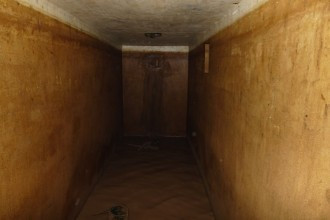
One of four long narrow rooms
In Joan Baez' album 'Where are you now my son?' you can hear her saying:
'We gathered in the lobby celebrating Christmas Eve,
The French, the Poles, the Indians, Cubans and Vietnamese,
The tiny tree our host had fixed sweetened familiar psalms,
But the most sacred of Christmas prayers was shattered by the bombs.
So back into the shelter where two lovely women rose,
And with a brilliance and a fierceness and a gentleness which froze,
The rest of us to silence as their voices soared with joy,
Outshining every bomb that fell that night upon Hanoi.'
Today, 40 years later, the shelter is empty. We hope it will never be used again for the same reason. We found an old wine bottle, still intact light bulbs, air ducts, graffiti and eerie echoes of a war that ended almost four decades ago. There will be ample opportunities to reopen the bunker and make it accessible to a select public. Hotel guests will be able to experience what Joan Baez and others went through. It will be a very special place in, or rather, under a very special hotel, a war memorial of its own kind.
'This is the most exciting discovery I have ever seen at a historic hotel,' concludes Kai Speth: 'we will handle it with care, dignity and responsibility.'
All photographs © Andreas Augustin
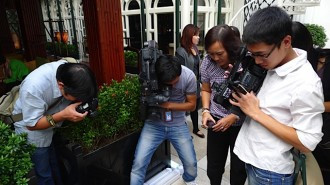
Later that week the local press was allowed in. Over 30 journalists appeared to discover the bunker.
Links: the book HOTEL METROPOLE HANOI by Andreas Augustin

